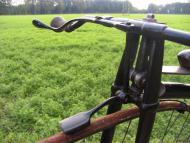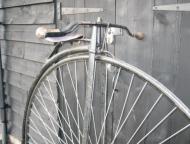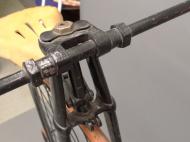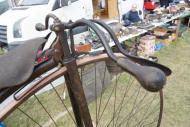Bayliss, Thomas & Co. was one of the major firms in the late 1870's and early 1880's. They started their Coventry based factory in 1874. The brand name was Excelsior, in later years they built motorbikes. Cycle production ceased in 1914.
At first, there was a model with plain/conical bearings front and rear, solid forks, a long, forward pointing spring and rear wheel brake. This model already had a hollow backbone. In this form, it was in the catalogue until 1881, when it was out of fashion for more than 3 years. The first penny farthing of Columbia (Standard Columbia) is a license built Duplex Excelsior.
In 1879 Bayliss, Thomas introduced their model DEHF: Duplex Excelsior Hollow Forks. It had hollow backbone, hollow forks front and rear, double ball bearing front and single ball bearing rear, ball pedals, front wheel spoon brake. A very modern bicycle for those years! Not very light, but indestructable. It helped to give Bayliss, Thomas a (very deserved) image of quality. At least in 1886 it is still in the catalogues. It may have been built in the following years - I do not have the later catalogues. It always has 60 spokes in the front wheel. In the USA, this model was sold as 'The Harvard'.
In the 1880's , there are several variations on this theme, like the Duplex Excelsior with hollow forks and plain bearings. Cheaper models sometimes had steel hubs, more expensive models always had brass hubs. All Bayliss, Thomas ordinaries in the 1882 catalogue still have straight handlebars. The 1884 catalogue shows bicycles with dropped handlebars.
1883 gives real news: It is the year of introduction of The Victor DEHF. This is top of the line, with detachable (cowhorn) handlebars and adjustable step. It is also the year of introduction of the typical Bayliss, Thomas spring, that forms half a circle at the end. Bayliss, Thomas calls it the 'rubber isolated spring'. In the following years, the more luxurious models are fitted with this spring, while the cheaper models retain the normal straight saddle spring.
Maybe from the beginning, but at least from 886 onwards The Victor has an oval backbone and fluted forks.
The typical 'open head' of Bayliss, Thomas gives a perfect clue to identify these bicycles. But: already in 1881 the more expensive models are also available with the normal 'Stanley-head' that all other makers use. DEHF becomes SEHF (Stanley Excelsior Hollow Forks) and also The Victor is available with Stanley head.
The safeties of Bayliss, Thomas are very interesting and well made. They really were top class makers and dared to stand out of the crowd.



